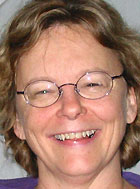Julie Morris, Ph.D., research associate professor in earth and planetary sciences in Arts & Sciences, is the new director of the Ocean Science Division of the National Science Foundation in Arlington, Va.
The NSF funds a substantial portion of the basic research performed by the U.S. academic community. Morris began her appointment April 24.

It is a “rotator” position, meaning she retains her appointment at the University during the duration of her NSF duties.
Morris will oversee a staff of more than 40 and a budget of slightly more than $300 million.
She estimates that about one-third of the NSF job will be in strategic planning for the division, including personnel and budget decisions. Another part will be working with other government agencies and organizations involved with research and management of the oceans, such as the U.S. Navy and the National Oceanic and Atmospheric Administration.
The balance of her time will be split between administration of the division and being part of the management team for the geosciences directorate, one of 12 that comprise the foundation.
“Both personnel and budget are on a different scale than I’ve ever worked with before,” Morris said. “I find that challenging and exciting. One of the things that I find particularly exciting is the exposure to a wide world of science beyond what I’ve been working with, and that’s exhilarating.”
Since October 2003, Morris has chaired the MARGINS office, a national NSF-funded science office that is a link between the foundation and the national research community, working on processes that control the formation and evolution of continental margins.
This gave her valuable experience in the management side of science and opportunities for science planning and management with many people around the country. It also put her in regular touch with NSF people, some of whom encouraged her to apply.
“I thought, ‘Why not?'” Morris said. “I think what interested me is that this is a job that requires the analytical skills that one uses in research plus the ability to work with people, make decisions and build consensus.
“I’ve been working on that in the MARGINS office. This position will allow both of those sides of myself to grow, in a way that research alone often doesn’t.”
Morris is eager to learn from experts who research physical, chemical and biological oceanography, marine geology and geophysics. In addition to research in these areas, the division supports many facilities and is a major funding source for research vessels used in oceanography and marine geology.
Many of the ships are owned by the Navy but operated through an organization called UNOLS, to which NSF is a major contributor. The famous deep-water submersible, Alvin, is funded this way, as well as its replacement being built now and capable of diving 6,000 meters.
As a geologist, Morris has a special interest in the oceans, particularly subduction zones, where the new lithosphere and oceanic crust created at mid-ocean ridges, along with sedimentary layers and trapped water are recycled into the deep mantle.
She has done lots of submarine research — including observing deep-water life in Alvin — but also a lot on land. She has explored the connection between volcanoes and earthquakes of the Pacific Ring of Fire, and their relationship to subduction zones.
Morris noted there are a number of ambitious new projects being funded through the Ocean Science Division. Among them is an a new phase of an international ocean drilling program, involving scientists from around the world using drilling ships and platforms provided by Japanese, European and American organizations.
Another is planning for ORION (Ocean Research Interactive Observatory Networks), which will develop and deploy observatories on the sea floor and in the coastal and open oceans to monitor activity in real time.
The division supports basic research in a wide range of topics, including marine ecosystems, the sub-seafloor biosphere, the oceans and human health, natural resources and natural hazards, the role of the oceans in climate change and geodynamics and plate tectonics of the solid Earth.
As a research professor, Morris does no traditional classroom teaching, but she does seminars, oversees research groups for students and a good deal of research mentoring.
Two of her graduate students, Dawn Cardace and Brian Dreyer, are finishing up their doctoral research within the next year.
As a rotator, Morris is able to return to the University from time to time for research, which will allow her to meet with her students.
Morris’s husband, Robert Tucker, Ph.D., associate professor of earth and planetary sciences, has a two-year leave of absence and will be moving with Morris to the Washington, D.C., area. He will be working on a project funded by the World Bank and carried out in part through the U.S. geological services for resource exploration in Madagascar.
“The timing was perfect for Bob and me, so it didn’t boil down to making a choice between a commuter marriage or not going,” Morris said.
“I have many exciting challenges ahead of me. At the heart of them is the need to keep the core program science funding healthy as the division invests a lot in new infrastructure and the science it will deliver.”